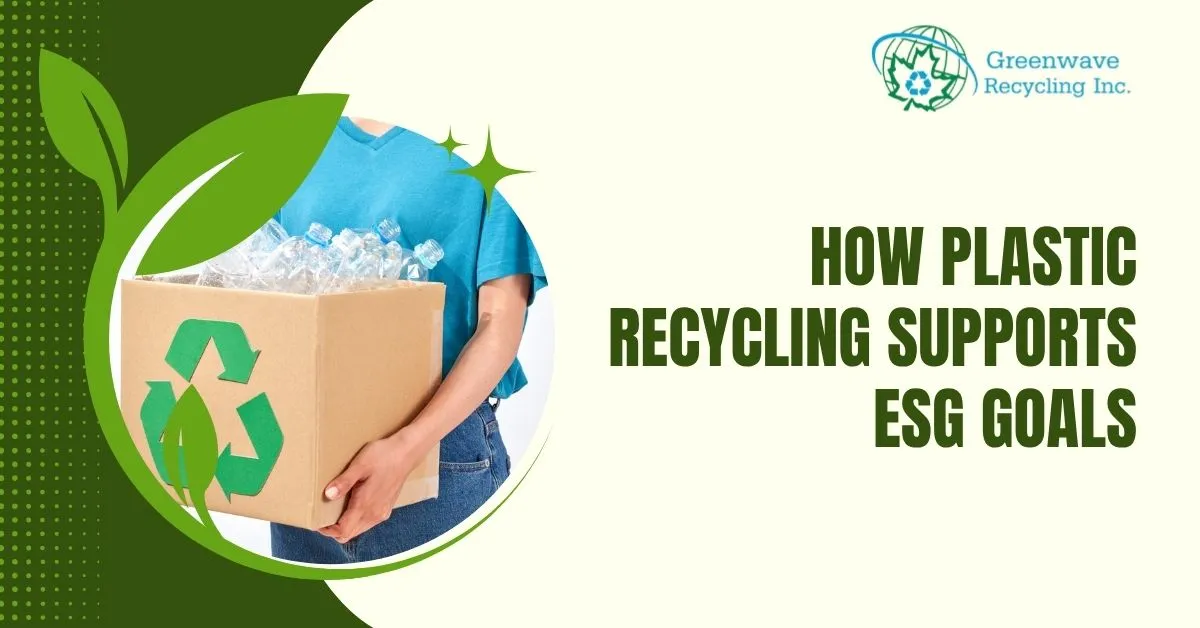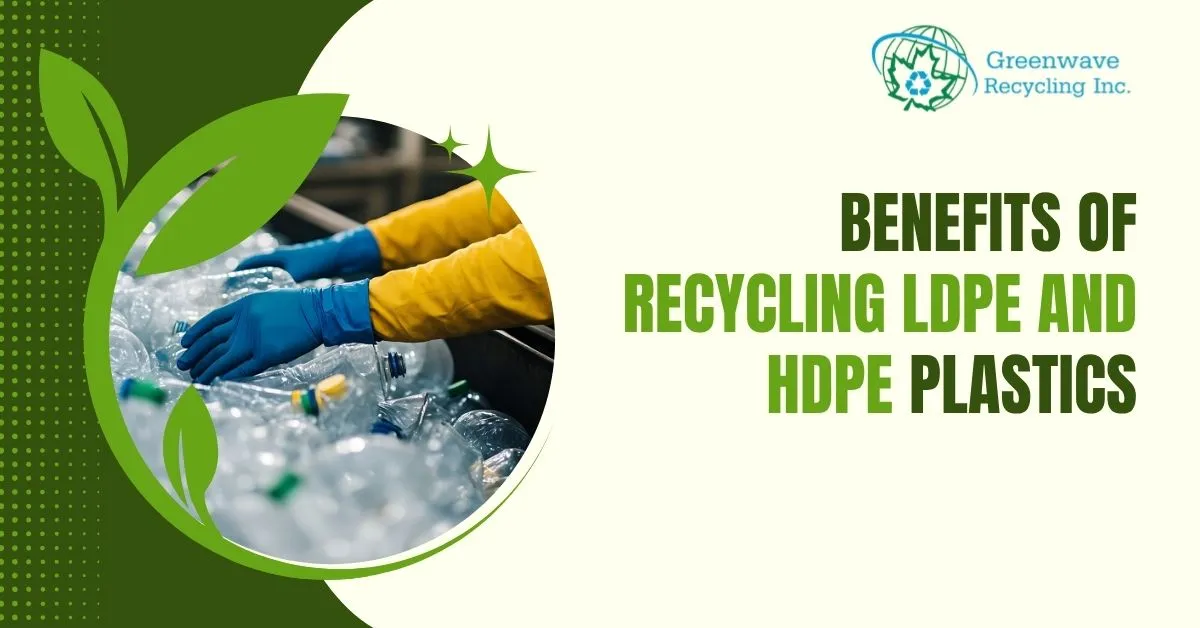Plastic waste continues to be a major environmental concern across Canada. Among the most commonly…

The plastics industry in Canada faces mounting pressure—from regulators, consumers and investors—to adopt sustainable practices. As businesses aim for robust Environmental, Social and Governance (ESG) credentials, plastic recycling is one of the powerful tools to deliver impact. By diverting plastics from landfills, increasing recycled content, and embedding circular economy principles, plastic recycling directly advances each pillar of ESG.
Understanding ESG and Its Relevance to Plastics Recycling
ESG is more than a buzz-word:
- Environmental (E) entails reducing greenhouse gas emissions, conserving resources and minimising waste.
- Social (S) covers community wellbeing, safe work practices and responsible supply chains.
- Governance (G) includes transparent reporting, ethical operations and regulatory compliance.
When companies integrate plastic recycling into their operations, they demonstrate tangible ESG performance—not just intent.
Environmental Benefits: Reducing Waste & Emissions
Plastic recycling supports environmental objectives in several key ways:
- Canada’s goal for zero plastic waste and a circular plastics economy is set out in the Federal Leadership Towards Zero Plastic Waste in Canada initiative.
- Recycling plastic reduces reliance on virgin fossil-fuel feedstocks, decreasing extraction and processing impacts.
- Example: Consumers and industry are increasingly demanding higher recycled content; the Canada Plastics Pact has set targets for at least 30% recycled content in plastic packaging by 2025.
By integrating plastic recycling, companies cut landfill diversion, lower CO₂ emissions and strengthen their environmental credentials.
Social Impact: Stakeholder Trust and Community Responsibility
Plastic recycling also yields social advantages:
- Companies that recycle plastics show they care about community health, reducing plastic pollution in waterways, soils and ecosystems.
- Better waste management practices reflect strong social commitment—helping secure customer trust, community goodwill and talent attraction.
- Recycling initiatives often create jobs across collection, sorting and processing sectors—supporting local economies.
In this way, plastic recycling becomes a force multiplier for the “S” in ESG.
Governance & Compliance: Transparency, Reporting and Risk Management
Governance demands credible, measurable evidence of sustainability. Plastic recycling plays a key role:
- With new proposals for minimum recycled content and mandatory labelling of plastic products coming from the federal government.
- Proper recycling programs require traceability: Companies must know where their plastic waste goes, who processes it and what the end-use is—this supports credible ESG reporting.
- Firms that proactively adopt plastic recycling reduce regulatory risk (for example bans on single-use plastics) and strengthen their supply-chain resilience.
Thus, effective plastic recycling helps organisations meet governance expectations and deliver on ESG commitments.
How Businesses Can Embed Plastic Recycling into Their ESG Strategy
Here are practical steps for Canadian businesses:
1. Conduct a waste audit – Identify plastic waste streams (LDPE, HDPE, PET etc.) and understand their volumes.
2. Set measurable targets – For example, increase recycled content in plastic packaging to 30% by 2030.
3. Partner with certified recyclers – Ensure that plastics are collected, sorted and processed in compliance with Canadian standards.
4. Track recycled content and report – Report the volume of recycled plastics used or disposed, which strengthens ESG disclosures.
5. Communicate clearly – Use accurate labelling, communicate your plastic recycling achievements to stakeholders and embed it in your brand story.
By taking these steps, companies in Canada can turn plastic recycling into a competitive advantage in ESG.
Looking to align plastic recycling with your ESG strategy? Contact us for compliant, sustainable plastic recycling solutions across Canada.
Industry & Policy Context: Canada’s Roadmap to Circular Plastics
- The federal strategy emphasises the need to keep plastics in the economy and out of the environment.
- Waste and recycling targets include: “100 % of plastic packaging being reusable, recyclable or compostable by 2025” and “at least 30 % recycled content by weight across all plastic packaging” under the Canada Plastics Pact.
- Industry players like Nova Chemicals Corp. are investing billions to improve recycled polyethylene supply chains and reduce CO₂ emissions.
This policy and industry activity reinforce the business case for plastic recycling as an ESG lever.
Common Challenges & How to Overcome Them
While the benefits are clear, companies may face challenges such as:
- Contamination of plastic waste streams which lowers recycling quality and utility.
- Insufficient market demand for recycled plastic content, causing volatility.
- Infrastructure gaps especially in remote regions for collection and processing.
Overcoming these challenges requires:
- Education and training to ensure clean plastic streams.
- Long-term contracts and partnerships to stimulate recycled plastic demand.
- Strategic logistics planning to aggregate and transport plastics from dispersed sites.
- Addressing these proactively translates into stronger ESG outcomes and sustained business value.
Case Example: From Waste to Value
Consider a Canadian packaging company committing to use 50% recycled content in its HDPE-based packaging by 2030. By working with a plastic-recycling partner, the company diverts its HDPE offcuts from landfill, sources recyclate, documents the material content and reports it in its annual sustainability report. The result: reduced disposal costs, stronger ESG metrics and a brand edge in a sustainability-driven marketplace.
Frequently Asked Questions
By reusing existing plastics, companies avoid the energy-intensive process of producing virgin plastics from fossil fuels—thus lowering CO₂ emissions.
The Canada Plastics Pact outlines an ambition of at least 30% recycled content by weight across all plastic packaging.
Yes. Even smaller firms that waste plastic can implement collection and recycling programs, helping reduce risk and improve sustainability credentials.
Proper labelling ensures consumers and stakeholders understand recyclability. Regulatory proposals in Canada aim to standardise labelling and prevent misleading claims.
Metrics include volume of plastic diverted, % recycled content used, reductions in CO₂ emissions and alignment with circular economy commitments.
Conclusion
Plastic recycling is more than just good environmental practice—it is a strategic enabler of ESG goals for businesses in Canada. It delivers measurable benefits across all three ESG pillars: environmental protection, social responsibility and governance integrity. With the right strategy, infrastructure and partnerships, organisations can convert plastic waste into value, strengthen stakeholder trust and contribute to a circular economy.
By integrating plastic recycling into their operations today, Canadian businesses position themselves for compliance, competitiveness and sustainable growth into the future.


